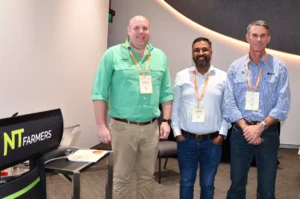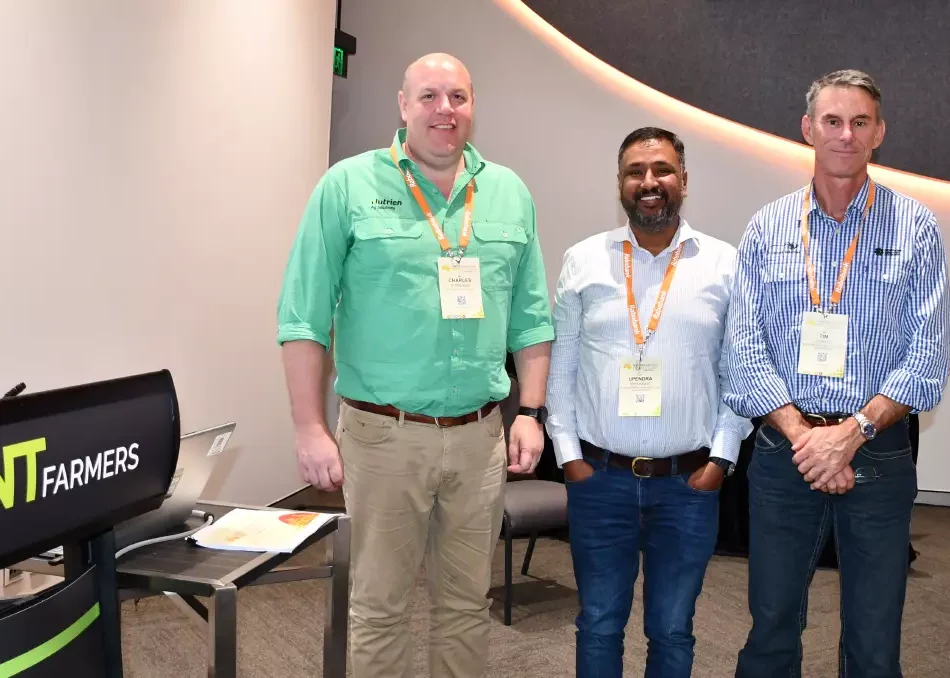Crops to cattle: weight gain trial shows promise in developing mutually beneficial northern system
Early promise is being shown in trials designed to foster the development of the northern cattle and cropping industries.
Northern Territory Department of Agriculture and Fisheries regional director and principal pastoral production research officer Tim Schatz spoke about the Crops for Cattle project at the recent Northern Australia Food Futures Conference in Darwin.
The aim of the four-year project is to integrate northern cattle and cropping industries to increase weight gains of cattle during the dry season and provide more stable markets for northern cropping enterprises.
The project is now its third year and will finish up in 2026.

Speakers at the Northern Australia Food Futures Conference included Nutrien’s Charles Starkings, and NT Department of Agriculture and Fisheries’ Dr Upendra Shekhawat and Tim Schatz. Picture by Paula Thompson
Mr Schatz said, unfortunately, there had been a long history of failed cropping enterprises in the north, often due to marketing issues.
But by selling crop products to local cattle stations, it should help the long-term profitability and stability of both sectors.
“The really important thing is that it has to be profitable for both industries,” he said.
“What we’re doing is investigating a range of different strategies using supplementary feeding.”
Supplementary feeding using locally produced feeds is aimed at increasing cattle weight gain during the dry season to achieve a higher proportion of steers being turned off after one post-weaning wet season, along with more efficient heifer performance from heavier pre-mating weights, resulting in higher pregnancy rates.
“As far as using supplements to increase heifer pre-mating weights, that has flow-on effects for pregnancy rates and getting in calf earlier,” Mr Schatz said.
Mr Schatz said there were issues getting steers to live export target weight by the end of the wet season.
“If they haven’t made that weight by the end of the wet season, they’re not going to grow over the dry season, so you really have to hold them,” he said.
“You’re looking at having them for another whole year but if we can get more weight on and more on a boat that frees up country to run more breeders.”
Mr Schatz said there were three main aspects to the trial.
The first involved documenting the increase in dry season growth that can be achieved through feeding different crop products and supplementary feeds produced in northern Australia. This work is being conducted on 10 commercial properties and two Department of Industry, Tourism and Trade research stations. The knowledge produced from this first step is the cornerstone of the other activities in the trial.
The second aspect is economic modelling, examining the whole-of-herd impacts of increased dry season growth on the structure, productivity and profitability of northern cattle herds, as well as determining the feed cost/cattle sale price combinations at which the different strategies are profitable.
“Rather than looking at the profitability of the feeding program in isolation, we need to look at the whole-of-farm effect,” Mr Schatz said.
“We need to know, in any given year, at this cost and this cattle price, is this strategy going to be profitable?”
The third aspect is the examination of the impact of increased dry season growth on reducing whole-of-life methane emissions, through having steers turned off potentially a year earlier and females being more productive and efficient so fewer breeders are needed. Whether these factors could provide an approved method for obtaining carbon credits will also be explored.
The outcome of this work will generate reliable data on the rate of live weight gain that can be achieved during the dry season in the NT from feeding different feeds including rations, forage crops and pellets, in various situations including in yards, in paddocks, in different locations and with different classes of cattle.
This information will be used to produce tables which show the break-even feed cost for various feeds at a range of cattle prices, giving producers better information to make decisions about potential feeding strategies each year based on real performance and not guesswork.
Some preliminary data has been released from the first year of a feeding trial at the Victoria River research station.
In June 2023, Brahman weaners were randomly allocated to either fed or control groups so that the groups had similar mean liveweights and the stocking rates matched the carrying capacity similarly in both paddocks.
The groups were grazed in similar paddocks and managed in the same way, except that the fed group was given Ridley pellets in the paddock for 97 days.
The pellets contained 31.8 per cent protein and were fed at an average rate of 1.27 kilograms/head/day.
Liveweight was recorded at the start and end of the feeding period after an overnight curfew.
The fed group gained an average of 54kg over the 97 day feeding period (0.56kg/day), compared to the control group’s 10kg average gain or 0.1kg/day across the same period.
The cost of the pellets (excluding transport and labour) was $1.21/kg and on average the animals consumed 123.6kg of pellets each over the 97 days.
At this feed price, the cost for the extra 44kg liveweight gain was $149.52.
Importantly, wet season weight gain was 11kg greater in the fed than the control group, so total weight gain over the post-weaning year was 53kg greater overall in the fed group.
“The important thing is that this information is objective, independent and verified, and it’s data from up here in our conditions,” Mr Schatz said.
“That’s why it’s important to have this data so we can assess strategies on realistic expectations.”
The Crops for Cattle project is funded through the Cooperative Research Centre for Developing Northern Australia (CRCNA).


